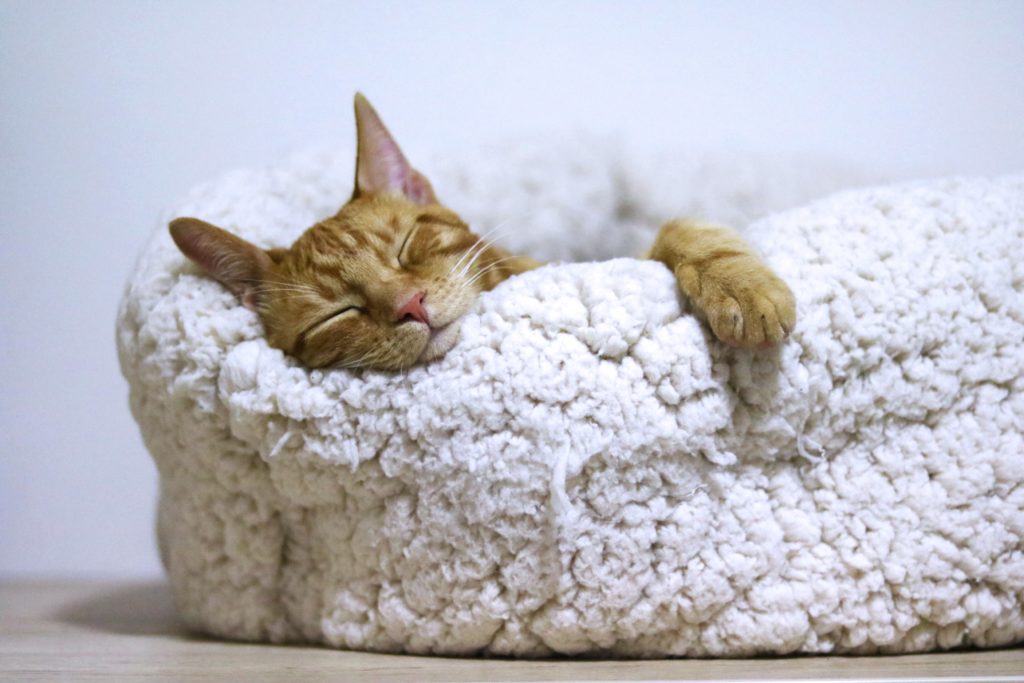Beware: Flame Retardants In Pet Bedding

It’s a fact that we live in a toxic world. In reality, there are chemicals in our water, air, food, clothing, furniture, flooring–we simply can’t avoid them!
Our cats are just as susceptible to these dangers as well. Toxins and chemicals are absorbed into their paws and ingested when they bathe themselves. Perhaps because we can’t see the dangers around us is why we don’t think about them. As the expression goes, “Out of sight, out of mind.”
Flame retardants and cat health
Whenever I get repeated issues suddenly popping up with clients it’s the universe sending me a message. Just this past week I’ve had five cases of flame retardants resonating as the underlying cause of health issues. Unfortunately, the common source of these chemicals turns out to be cat bedding.
The dangers of flame retardants are very serious. In fact, the use of these organophosphate esters have become pervasive in our homes in recent years, even in household dust.
Tests on household dust have found very high levels of PBDE, (polybrominated biphenyl esters found in flame retardants) to be a common occurrence in many homes. In tests, humans in the US have been found to have the highest levels of PBDE in their systems worldwide, but even more worryingly, some US cats have been found to have PBDE levels 100 times higher!
https://www.catsessentials.com/blogs/blog/feline-hyperthyroidism-linked-to-flame-retardants
Furthermore, a study published by Environmental Science and Technology shows exposure to flame retardant chemicals, which are endocrine disruptors, do contribute to the disease development of hyperthyroidism in cats. Sadly, two of my clients have recently been diagnosed with hyperthyroid issues, and energetically I traced it back to flame retardants in cat beds.
Toxins and immune response
The other three cat clients are struggling with excess histamine release resulting in itching, twitching, or allergic-type reactions. Exposure to flame retardant toxins and PBDEs causes an immune response, resulting in a histamine release throughout the body. When there is a large amount of histamine released it can cause the lymph to become sluggish. As the sluggish lymph flows beneath the skin or in the interstitium, this can irritate the nerves. The result is itching, rashes, tingling, skin rippling, and leg flicking which prompts the cat to scratch or lick in an effort to self soothe.
Cats who have been diagnosed with conditions like FHS (Feline Hyperesthesia Syndrome) recognize these symptoms all too well. Therefore, rather than resort to suppressing the immune system with steroids and other medications, we need to do some detective work to discover why this is happening in the first place. Next, it’s important to eliminate the cause!
What about laws against using flame retardants?
Fortunately, there is good news in the human space concerning flame retardants, but not for pets yet.
Thanks to two victories achieved in large part because of Earthjustice’s work, as of January 2014 it’s now easier for consumers to find and purchase furniture free of flame retardants. It’s easier, but not easy enough—yet. The new regulation that went into effect in 2014 doesn’t actually ban flame retardants; it just makes it more feasible for manufacturers to forgo using them and still adhere to existing regulations. Now that two classes of flame retardants, brominated and chlorinated, have been in the news a lot lately for their harmful effects, some companies are simply switching to flame retardants that aren’t as familiar to the public (and are less studied by researchers).
https://earthjustice.org/blog/2016-april/doggie-dilemma-limiting-flame-retardant-exposure-in-pets
When it comes to flame retardants in pet bedding, cheap foam is a common source of them. The new labeling law doesn’t, however, cover pet furniture or individual pieces of foam (commonly used in pet bedding). Organizations like the CEH offer free flame-retardant testing of foam products, Duke University’s chemical testing program offers more comprehensive testing.
When it comes to safe cat bedding look for organic fibers and materials, including cotton, wool, silk, or natural latex foam. In addition, make your home safer by using HEPA filtered vacuums and air filters to help reduce the amount of PBDEs in the air and on the floor, too.
Healthy detoxification for flame retardant exposure
After you toss out the cat bed with flame retardants, it’s time to do some cleansing. Fortunately there are some simple ways to help support the liver and eliminate these chemicals from the body if your cat has been exposed to flame retardants.
- Milk Thistle twice a day for 4 weeks to support/cleanse the liver.
- Heavy Metal & Chemical Cleanse by Global Healing–1 drop per 15 pounds daily for 4 weeks
- Ion Gut Support for Pets–1 tsp daily for 4 weeks
If you suspect your cat’s thyroid may be out of balance, have a blood test done by your vet. If thyroid levels are above range consider adding a thyroid support supplement like Thyroid Support Gold by Pet Wellbeing or ResThyro by NHV Natural Pet Products. Finally, I suggest retesting two to four weeks after detoxing is completed to find out if the thyroid levels have rebalanced.

